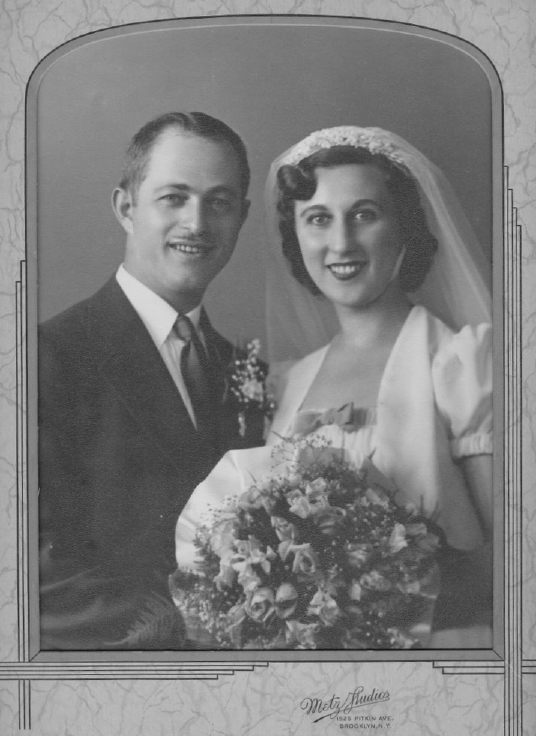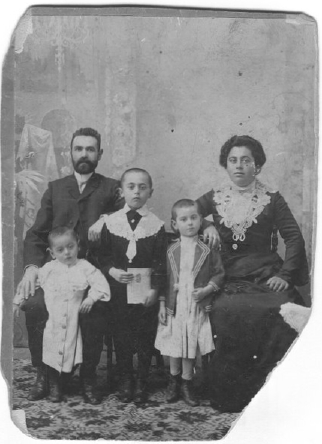
Reconnecting with Kishinev
Pages of Testimony Link Living Cousins
“Yad Vashem, memorializing those who perished, had made possible something more—reconnecting the living.... Sam had tried to find out if he still had relatives in the United States ..., but without success. 'In all these years,' Sam said, 'this is the first time somebody found me!'.”
This story was originally published in the Summer 2007 issue of "Roots Key," the journal of the Jewish Genealogical Society of Los Angeles. Reprint permission granted. —NS & MH Kichineff le 2 Aout 1938 “Dear aunt!—Although I don’t know you personally, I feel a duty to thank you for ....” So begins a letter my grandmother received from her nephew, Gricha Corenfeld, in the summer of 1938. Gricha was the son of my grandmother’s oldest sister, the only one of her siblings who remained behind in Kishinev—as my grandmother, her parents, two brothers, and four other sisters had all left for America in the wake of the pogrom of 1903. She had not seen any of them for thirty-five years! Now, on behalf of himself and his family, Gricha was thanking my grandmother—one of the American aunts he had never met—for the wedding picture she had sent of my parents, who had been married that June.
It was in French because Gricha had studied medicine in Paris, but he was now back in Kishinev, anticipating taking the state medical exams that would allow him to practice, doing a year of military service, and then marrying his fiancée. He said he would send pictures of himself and his fiancée. And then there was silence. When my mother died in 1998, I rediscovered the letter, which she had very likely saved because it praised the attractiveness of the young newlyweds. From conversations with my mother, I knew that my grandmother’s sister and her husband were believed lost in the holocaust. I also knew that one of this sister’s sons had emigrated to the United States just before World War I, but he and his wife had died childless in the mid-sixties. My sporadic efforts to find a Gricha Corenfeld—or Korenfeld —or Kornfield, as the son in the United States had spelled it—had proved futile. I was uncertain even of his parents’ names. My mother had dimly remembered that her mother’s sister’s name was “something like Marin.” She did not know the husband’s name at all. We did have a picture—presumed to be of the sister, her husband, and three small children—taken shortly before or after my grandmother came over in 1903. But the picture just had the single word Polonsky—my grandmother’s maiden name—penciled in Russian on the back. Trying to find out anything more seemed like an exercise in futility. Two things changed all of this dramatically. A JewishGen Romania-Moldova SIG project to translate the Kishinev vital records from the LDS microfilm holdings had begun to make available a continuous stream of new data online. And Yad Vashem had finally committed its Pages of Testimony to the internet. “This is the first time somebody found me!” Still, that was in 1991. This was 2007. Was Samuil still alive? Still in Kishinev? I wrote to the Kishinev address and, not surprisingly, received no response. I began to conjecture about the possibilities: He had moved elsewhere in Moldova—no Moldova white pages are available online. He had died. He had emigrated to the United States, or to Israel, or .... I decided to pursue the scenario that might at least give me an outside shot at finding him. Suppose he had come to the United States? The unusual spelling of Samuil, and a less common spelling of a common last name, might mean I could find him on switchboard.com. I entered the name. Just one hit came up—at a Denver address! I called, and was answered by a gentleman with a promisingly Russian accent. “Yes, this is Sam.” Are you the Sam S. who submitted pages of testimony to Yad Vashem for Maryam and Simkha Korenfeld?” “Yes,” his voice betraying some surprise, “they were my grandma and grandpa.” I replied, “My grandmother was Maryam’s sister Zelda. You and I are second cousins.” The conversation that followed was lengthy, but totally confirmatory. Sam and his family had been in the United States for fifteen years, having been prompted by the deteriorating economic conditions accompanying the collapse of the Soviet Union to leave Moldova shortly after the pages of testimony had been submitted. Sam knew of the son Louis (Leib—Sam’s uncle) who had come to the United States. Communication was difficult and sporadic after the War; the Stalin regime had discouraged communication with the West and perhaps one letter or parcel in five would get through. Gricha, too, was Sam’s uncle. But Sam had known Gricha. He had lived into the 1980s. His children and grandchildren are now in Russia and Israel. We agreed to send each other pictures and details by mail, since Sam, now 80, and having arrived in the United States knowing no English, was still somewhat uncertain of his telephone English (which actually is remarkably good). The next day Sam called back. “I remembered something else that I want to tell you about.” He told me how before the war they had received a wedding picture from America. It had been on their piano until they had to abandon Kishinev, leaving everything behind. But he was a boy then. He didn’t remember who the couple were. Family? Movie people? Did I know? I was able to tell him, “I have the thank-you letter for the picture.”
We were now getting beyond the bare bones of archival information and into the stuff of memories and lives—corroborating memories from lives lived separately on opposite sides of an almost impenetrable divide for three generations. I sent Sam photos of his American relatives. I sent him a copy of the 1938 wedding picture, and a copy of the thank-you note. I sent him a copy of the photograph that I thought was his grandparents, Simkha and Maryam. Yes, he responded, indeed it was his grandparents and the child closest to Maryam in the picture—hair so closely cropped I had not realized it was a girl—was Sam’s mother. It was a picture he had not seen in sixty-seven years. A week later, I received a call from Sam’s son, Vitaly, in New Jersey. They were having a large family reunion the following weekend. Sam and his wife would be there from Denver. Could I come? I paused—I live near Boston—but not for long. How could I not! Yad Vashem, memorializing those who perished, had made possible something more—reconnecting the living. I had once before used Yad Vashem records to put an elderly Russian émigré in touch with a first cousin he had not seen in over fifty years. Neither had known the other was in the United States. This time, though, Sam and I were the beneficiaries of Yad Vashem’s going online. Sam had tried to find out if he still had relatives in the United States when he first arrived here, but without success. “In all these years,” Sam said, “this is the first time somebody found me!” Memories of those who remained Interestingly, much like many Jews in the United States at that time, Sam’s family was upwardly mobile within the larger society. Gricha had studied medicine; Sam’s older brother Isaak was studying architecture in Odessa. Then came June 1941. The Germans were on the move, and with them the Einsatzgruppen (German mobile killing squads). Sam and his parents had been visiting Isaak, expecting to return home in a few weeks. Instead, they had to flee further east, to Kharkov. There the Russian draft caught up with Isaak. They never saw him again. Sam and his parents ultimately survived the War by fleeing much further east to Kazakhstan, along with many other refugees from Bessarabia and elsewhere, living in conditions of deprivation and constant hunger. The U.S. Holocaust Museum has now made archival records of refugees in neighboring Uzbekistan available online. Access to living memory is precious. We read of our forebears who came here and missed the loved ones they left behind. We do not as readily learn how separation affected those they left behind. Sam remembers his grandmother Maryam as always being very sad. She felt like she had no more family—her parents and her brothers and sisters had all gone to America. Her husband had not wanted to emigrate because he was in business with his family and the family business was there in Kishinev. So they stayed, and with only his family as solace, she longed for the people who had gone out of her life. Could Maryam and my grandmother Zelda even imagine their grandsons one day embracing? With persistence and a great deal of luck, genealogy can sometimes lessen the finality of the breach. July 2011
|
|||||||||||||||||||||||||||||||||

